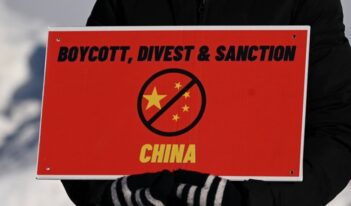
In the 13th Five-Year Plan, China aims to fulfill its commitment in the Paris Agreement.
The world is watching how the United States and China, the two biggest carbon emitters and economies in the world, have committed to implementing the Paris Agreement on climate change. The United States faces uncertainty over its ability to deliver on its commitment, given that the Obama Administration’s Clean Power Plan is still pending in court. What exactly is China’s plan, and will it work?
China’s National Congress recently passed its 13th Five-Year Plan, an overarching social and economic roadmap that includes climate change issues. For the first time, the Five-Year Plan adopts “green development” as one of the major visions and lays out specific agendas to promote clean energy and reduce carbon emissions. Those agendas include:
- to advance low-carbon technology in various industries;
- to build industrial models with zero carbon emissions;
- to create a nation-wide market for carbon emissions trading; and
- to carry out the nation’s international commitments about climate change.
The Five-Year Plan also requires that China keep its total energy consumption under 5 billion metric tons of energy each year by 2020. According to China’s annual Statistical Communique, China’s total energy consumption reached 4.3 billion metric tons of energy in 2015 with a 0.9% growth rate.
To implement this Five-Year Plan, China’s State Council last month laid out its 2016 legislative schedule. The State Council has prioritized amending the Regulation on Environmental Management of Construction Projects, which has not been updated since 1998. It also seeks to complete the Environmental Protection Tax Law and draft a new law on energy and regulations on carbon emissions trading.
The Five-Year Plan has received positive comments from members of the international community. Li Shuo, a senior climate policy adviser at the Greenpeace East Asia, reportedly argued that the Five-Year Plan’s explicit reference to China’s Intended Nationally Determined Contribution (INDC) under the Paris Agreement indicates China’s ambition of “becoming a global leader in reining in emissions.”
Fergus Green and Nicholas Stern, two climate policy experts at the London School of Economics and Political Science, predict that China may realize its goal in the Paris Agreement earlier than it committed. By analyzing China’s economic data by the third quarter of 2015, Green and Stern conclude that China is undergoing a major economic transformation from an “energy-intensive, heavy industry-based” growth to one that is “sustainable and inclusive.”
In China’s INDC, China promised to reduce the rate of growth of carbon dioxide emissions and “achieve the peaking of carbon dioxide emissions around 2030.” Green and Stern argue that if China succeeds in carrying out its latest Five-Year Plan, China’s carbon dioxide emissions “are likely to peak at some point in the decade before 2025.”
Although the Five-Year Plan suggests that China is taking seriously the need to tackle climate change, specialists at the World Resources Institute, an independent research organization based in Washington, DC, argue that China may be unable to “decouple emissions from economic growth.” The specialists point out that China is still experiencing “increased urbanization and vehicle ownership,” which can be a major source of potential carbon emissions growth. Therefore, to address the crux of their emissions crisis, they recommend that China prioritize increasing the energy efficiency of residential and work buildings and decreasing the demand and dependence on automobiles.
In addition, critics assert that China has not done enough to mitigate climate change, pointing to the conservative terms of the Five-Year Plan.
Deborah Seligsohn, a researcher at the University of California, San Diego, and Angel Hsu, an Assistant Professor at the Yale School of Forestry and Environmental Studies, argue that the Chinese government’s targets in its Five-Year Plan are too “easily manageable” given China’s success with surpassing energy and carbon targets in the 12th Five-Year Plan. Diego and Hsu provide evidence that the coal consumption has been evidently declining in the past five years, suggesting that the annual cap of 5 billion metric tons of energy would naturally overlap with this existing trend.
Apart from meeting China’s climate change commitment, the latest Five-Year Plan may influence both foreign investments in China and China’s oversea investments in green technology. Partners at King & Wood Mallensons, a top Chinese law firm, identify the Five-Year Plan as the Chinese government’s gesture to further open the domestic market for foreign investors to transfer low-carbon technological innovation into China. On the other hand, E3G, a European-based not-for-profit company, argues that the Five-Year Plan intends to expand its clean technology investment overseas, which may challenge Europe’s low-carbon market.
The world will watch with great interest what kind of progress China makes on reducing carbon emissions as it starts carrying out its Five-Year Plan this year.



